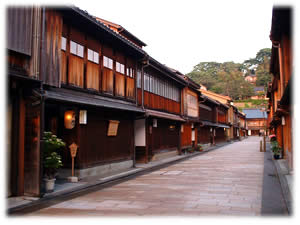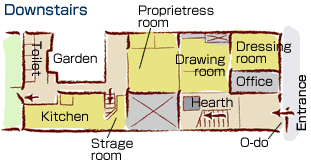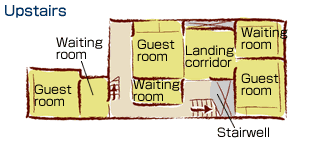
| @ | The Higashi Kuruwa (a high-class, eastern
pleasure quarter) was established in 1820 by the Kaga feudal government. The street lined with houses, each having a lattice door plastered with Benigara Kooshi (Indian red) and a big door, is one of the old atmosphere of feudal days, and it is one of the most sentimental areas in Kanazawa. The Kuruwa was crowded with the wealthy tradesmen and men of letters who sought the upper circles of society and its pleasures. They enjoyed watching geishas perform many Japanese fine arts : the koto ( a Japanese harp), the shamisen ( a three-stringed instrument), dancing, youkyoku ( Noh songs), tea ceremony, tanka ( 31-syllable Japanese poems), haikai ( 17-syllable verses), each of which was expected to be a highly cultivated technique. That is party why Kanazawa is known as being excellent in fine arts. Many of these OCHAYA (tea houses) have changed into other styles of business, such as rooms to let or Japanese-style restaurants. But you can still see the traditional performing arts come alive in the performances of the beautiful, talented geishas of today. |
@ |

| Through the long history of this OCHAYA, the name
has changed many times. It is now called "SHIMA" (goodwill of
the guest house). But it was called "Etchu-ya" in the days of Bunsei era (in 1820's), "Owari-ya" in the twenties of Meiji era (in 1880's) and "Takegoto" from the Taisho period to the begining of Showa (from 1900's to 1930's). Today we treasure the typical style of OCHAYA, which has officially been recognized as valuable, culutural heritage. |
|
In addition, you may be interested in its interior. The Irori (a hearth), Oo-do (a big door), and the unique room arrangements without closets make this house much different from the houses usually seen in towns. and you are sure to find a waiting room attached to each main guest room, where entertainments were performed by talented geishas to please guests. |
 |
 |
Guests in the main room can enjoy some accomplishments, such as the shamisen, dancing, etc. performed in the waiting room. Perhaps no place else in the nation can you find the unique, traditional atmpsphere of guest houses in this Higashi area. |
| [ Guidance inside a hall ] |

 |
| An "ochaya" while literally meaning
"tea house" was actually a place for customers to be entertained by
Geishas as they drank sake. As a rule, an "ochaya" such as Shima would have been exclusively patronaized by upper class marchants. Shima was constructed in 182 years ago and excepting only the electric lighting and modern toilets, remains much the same today as when it was built. In the feudal period, when Shima was built, there were many restrictions on building construction. One restriction was on the height, and Shima is one fo the few buildings of the time allowed to have a second story, one indication as to how luxurious it was. In an "ochaya", a "zashiki" guest room is always paired with a "hikae-no-ma" waiting room. The customers would sit in the guest room and the waiting room would serve as the "stage" for the Geishas to perform their song and dancer routines. A part from the annex, all the wood surfaces in this building have been lacquered, and the door catches are cloisonne ware. Shima, this building has been designated as an important cultural properties by the Japanese government.(the only building so designated) However, with the passage of time, Shima has become rather worn out, and now it is quite hard to maintain the building. The guest rooms were all on the upper floor, while the proprietress quarters and Geishas dressin room were on the ground floor. |